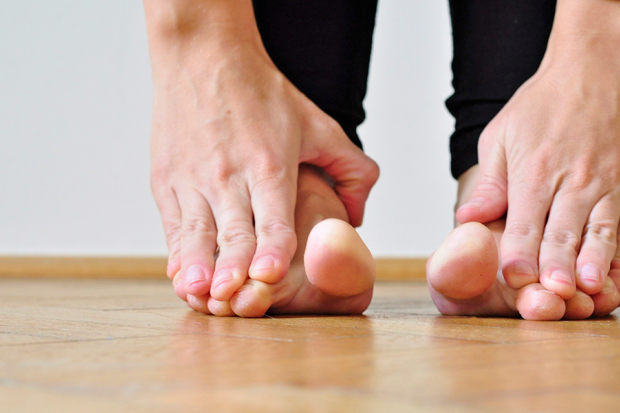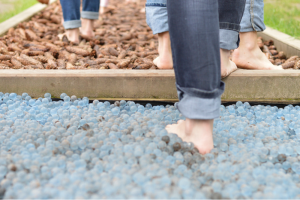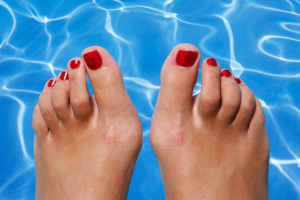No More Duck Feet Splay Foot Symptoms And Treatment Exercises
Learn how to tell if you have the common foot problem known as splay foot and simple treatment exercises that help ease splay foot pain.
Though it’s a common foot problem, the deformity known as splay foot isn’t given as much attention as it deserves. More and more people are being diagnosed with the foot condition, which is characterized by the metatarsal bones of the foot spreading and making the foot wider, which leads to arch collapse and foot pain. But how do you know if you have splay foot? And if you do, what can you do to make sure the foot problem doesn't become worse? Here are splay foot symptoms to look out for, as well as splay foot exercises that can help reduce the pain and prevent further metatarsal bone spreading.
Symptoms That May Point To Splay Foot
Millions of people experience foot pain in their lifetimes, but many assume foot aches and pain are a normal part of aging. However, podiatrists across the nation agree that foot pain is never normal, and every type of foot pain deserves to be assessed and diagnosed. Here are some common symptoms that may signify your metatarsal bones are spreading and you have developed splay foot:
- Your shoes feel tighter and more uncomfortable than they ever have before
- You can physically see that your feet have become wider
- Your foot pain is worse when you’re walking or standing, and the pain decreases when you’re at rest
- You find yourself walking on the outside edge of your feet rather than pushing off from your big toe while taking steps
- Your shoes lean to one side when you place them on a flat surface or they wear down more quickly on the outside edge, which indicates you may be walking improperly to avoid splay foot pain
- You suddenly begin developing calluses or pressure sores from walking with your weight distributed differently than usual
- Months or even years after your foot pain begins, you start to develop deformities like claw toes, hammertoes or bunions (all of which can form when your weight distributions shifts to other parts of your foot and puts strain on different bones, joints and ligaments than usual)
What Causes Splay Foot?
Expert disagree as to the exact cause of splay foot, but many point to years of improper strain on the foot due to things like obesity or wearing unsupportive or uncomfortable shoes like high heels. Bone disease, paralysis, and a weakening of the ligaments and connective tissues in the foot (a common problem among aging women) can also cause the metatarsal bones to start spreading and breaking down.
As the metatarsal bones begin to spread further and further apart, the resulting foot pain often causes a change in walking style. People with splay foot often begin walking on the outside edge of their feet to avoid pain, rather than pushing off from the toes. This change in gait causes further weakening of the foot muscles as well as possible arch collapse — both of which actually make splay foot more painful.
Splay Foot Treatment: Foot Exercises Are Best
One of the ways to decrease the pain caused by splay foot is to wear custom-fitted orthoses that help patients return to their normal gait. However, orthoses are widely considered a temporary solution because the feet eventually become dependent on the passive support provided by the orthosis and continue to weaken. The patient quickly becomes accustomed to the insoles and the pain returns over time — leading the patient to walk abnormally again, which can lead to knee and back pain as well as calluses. Therefore, more and more podiatrists are recommending their splay foot patients engage in foot strengthening exercises, as working the muscles in the feet can stop the metatarsal bones from further widening, create greater foot support and stability, and can help reduce splay foot pain.
RELATED: Are your feet actually to blame for hop, knee and back pain?
Foot Strengthening Splay Foot Exercises
There are several simple exercises patients with splay foot can do to help strengthen their feet and prevent pain. They include:
- Toe Pick Ups: Commonly used to help relieve bunion pain, toe pick ups can help splay foot symptoms, as well. The exercise consists of picking up small objects such as pebbles, marbles or tiny toys with your toes and depositing them in a bucket or other container.
- Arch Strengthening Caterpillar: Recommended by Erika Bloom from the Erika Bloom Pilates Plus center in New York City, the arch strengthening caterpillar exercise begins by lying on your back with your knees bent and your feet flat on the floor about two feet from your butt. Lift both foot arches and pull your toes back toward your heels. Relax your arches and slide your feet slightly back toward your butt. Repeat the process, allowing your feet to inch closer and closer to your glutes in a caterpillar motion. Once your feet are nearly touching your butt, repeat the sequence in reverse, slowly moving your feet away from your butt in the same caterpillar motion.
- Arch Raises: Sit in a chair with your back straight, your knees bent in a 90 degree angle and your feet flat on the floor. Raise the arch of one foot off the floor without curling your toes or lifting your heel. (It’s much harder than it sounds!) When done properly, you should feel muscle strain in your foot, lower leg and thigh.
- Alphabet Writing: You can strengthen your entire foot by imagining a pencil in between your toes, pointing the toes outward and “writing” the alphabet in the air in front of you.
- Walking Barefoot: It might sound counterintuitive, but frequently walking on natural surfaces like sand, smooth pebbles and grass can actually help strengthen your feet and legs and assist your body in returning to its natural gait. In fact, barefoot parks and trails designed specifically for shoeless users are becoming a popular healthy living trend for those very reasons.
For more on splay foot, read our Wiki article covering the common foot condition.
Notice concerning medical entries:
Articles having medical content shall serve exclusively for the purpose of general information. Such articles are not suitable for any (self-) diagnosis and treatment of individual illnesses and medical indications. In particular, they cannot substitute for the examination, advice, or treatment by a licensed physician or pharmacist. No replies to any individual questions shall be effected through the articles.







